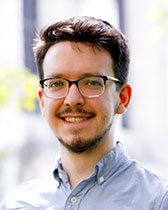Student Spotlight: Zachary Urbach

By Irena Garic
Where are you from, and where did you go to school as an undergraduate?
I am from Lakewood Ohio, just outside Cleveland. For undergraduate I hopped over to Pittsburgh, PA to attend Carnegie Mellon University.
How did you become interested in your research?
I worked for Michael Bockstaller as an undergraduate student and did research with polymer-grafted nanoparticles for phononic and photonic applications. The structural characterization at the nanoscale and understanding assembly mechanisms was really interesting to me. This colloidal organizational behavior is what brought me to Northwestern to work with Chad Mirkin. Once here I constructed a thesis around using magnetic nanoparticles in combination with DNA-mediated interactions to control assembly behavior.
How would you explain what you study to non-scientists?
Magnets can attract or repel each other across many length scales. Nanoparticles (objects on the length scale of billionths of meters wide) made out of iron oxide can act as tiny magnets but only repel or attract when an external field is applied. This creates a way to control when particles assemble together or stay separated. To further control how these nanoparticles assemble, DNA can be attached to their surfaces to act as a sticky Velcro of sorts, to combine particles together even if no field is present. When both DNA hybridization and magnetic interactions are combined, interesting structures form that either interaction alone could not form.
What are some potential applications for the work you’re doing?
These DNA and magnetic based nanoparticle assemblies could one day be used for nanorobotic applications. Current studies with magnetic nanoparticles as robots use external fields to create swarms of particles that can push micron sized objects around. DNA on the surface of the particles presents an opportunity to interface them with biological material and be able to control their motion and reconfigurable structure through external fields in cells for instance. This is still a way off but the fundamental assembly behavior and structural characterization is key to realizing the ambitious goals of nanorobotics.
What has been the highlight of your academic career thus far?
Finishing and publishing a project using cubic iron oxide nanoparticles to assemble into ordered and oriented lattices through the use of both DNA and magnetic interactions. The cubic shape presented many synthetic challenges along the way, and the structural characterization through small-angle x-ray scattering was also made more challenging due to the non-spherical shape. Being able to wrap the project up, tell a full story about the structure and material, and have it published and presented to the world was a deeply gratifying experience.
What do you miss the most about the Mirkin Group?
The availability of resources and speed of research. The only limiting factor in the Mirkin Group is yourself and so when you want to get a lot done, you get a lot done. Here at UC Irvine the pace is still high but I am joining a new MRSEC so there are collaborations and resources to coordinate and instruments to get operational. It’s a different experience than jumping into a well-oiled machine but a valuable one if I hope to start a small lab of my own someplace down the line. Also of course I miss many of colleagues and friends who I am staying in touch with!
Since you obtained your PhD last December, you have been a postdoctoral fellow at UC Irvine (Hochbaum Lab). Tell us more about the transition and your new projects?
The ride west was fun! I rented a UHaul and drove cross-country through the southwest and made some stops at National Parks. I found a nice apartment with a backyard (rare for this part of California). I’ve transitioned well here at the University and have taken a lot of initiative to start work and collaborate. I need to thank Chad and the Mirkin lab and really Northwestern Chemistry in general for that drive they instill in their students.
In the Hochbaum lab, I am studying the self-assembly of peptides which form coiled-coil structures (alpha helices wrapped around one another). The particular type I study form hexamers of helices that then stack like barrels to form fibers. A major goal is to create a dissipative hierarchical structure because in nature cells are constantly forming and breaking down complex nano- and micron-sized objects such as during mitosis. To create a transient system like this, redox sensitive bonds will be installed into the peptides and through chemical fuels the bonds will be formed and later broken to control how long the fibers are stable. This general class of peptide fibers was recently shown to have conductive properties as well. The ultimate goal therefore is to control the assembly to elucidate structure-property relationships in the fibers.
